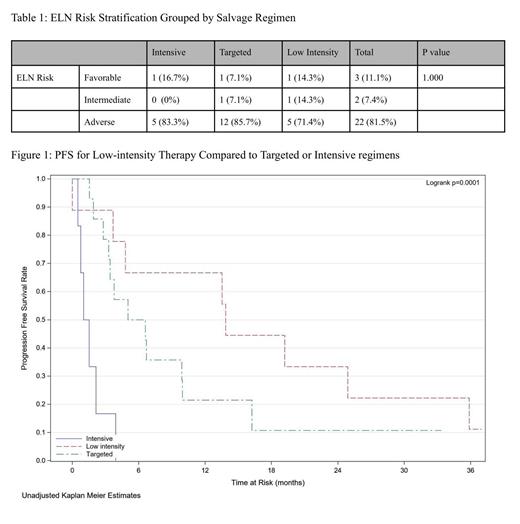Background: Acute myeloid leukemia (AML) is an aggressive hematological malignancy arising from immature myeloid progenitors with notoriously poor outcomes, particularly in the elderly. Venetoclax (Ven) plays an essential role in acute myeloid leukemia (AML) directed therapy as it is approved for frontline therapy in combination with azacitidine (Aza), decitabine (Dec), or low-dose cytarabine (LDAC) for patients aged 75 years and older, or those with significant comorbidities. However, venetoclax-based therapy is not curative, and the ideal salvage regimen is unclear in these patients. We performed a retrospective review that analyzed a single center's venetoclax-based regimens to identify rational subsequent lines of therapy after failing venetoclax.
Methods: We conducted a retrospective review of adult patients at Roswell Park Comprehensive Cancer Center who had a confirmed AML diagnosis and received a venetoclax-based regimen as upfront therapy between January 2015-February 2023. Demographics, prior hematological disorders, ELN risk stratification, Eastern Cooperative Oncology Group (ECOG) performance status, treatment received in upfront vs relapsed/refractory settings, date of remission/relapse, disease-specific variables [molecular data, cytogenetics], and outcomes [duration of response, time to progression, MRD status, and overall survival] were collected. Of note, in patients who received upfront venetoclax regimen, the subsequent salvage therapy was grouped by targeted (Gliterinib, Enasidenib, Ivosidenib), low-intensity (single agent hypomethylating therapy, gemtuzumab, ozogamicin), or intensive groups (CLAG-M) and analysis was performed for progression-free survival (PFS).
The patient demographics and clinical characteristics were summarized by group (i.e. response, regimens) using the Mann-Whitney U and Fisher's exact test. Survival functions were described by the Kaplan-Meier method and compared with the Log-rank test. Analyses were performed in SAS v9.4 (Cary, NC) at a significance level of 0.05.
Results: The retrospective study analyzed 97 patients. In the upfront analysis, the median age was 73.4 years (range: 51.4-89.8) and 64 (66.0%) of the patients were male. 65 patients (67.0%) received Aza/Ven, 26 (26.8%) Dec/Ven, and 6 (6.2%) LDAC/Ven. Per ELN 2022 criteria, 13.3% of patients were stratified as favorable,12.2% as intermediate, and 74.4% as adverse risk. Of the adverse risk patients, 67/97 (69.1%) patients received Aza/Ven. Median survival time for all upfront induction regimens was 15.8 months (95% CI: 8.1-22.6), greatest median survival with Aza/Ven of 19.1 months (95% CI:10.4-23.6). Median PFS by all induction regimens was 8.9 months (95% CI: 5.0-13.9) with the greatest median PFS being Aza/Ven at 10.9 months (95% CI: 6.6-20.2); p=0.045).
Overall, 29 out of 97 (29.9%) patients received salvage therapy. These included 19 (65.5%) males with 93.1% of patients being Caucasian. The majority of patients (81.5%) had adverse ELN risk stratification (Table 1). Total 1-year survival rate is 0.050 (0.31-0.67), with intensive 0.050 (0.16-0.67), low intensity 0.67 (0.35-0.86), targeted 0.39 (0.18-0.60). Total 3-year survival rate is 0.19 (0.06-0.38) with intensive 0.17 (0.02-0.46), low intensity 0.30 (0.08-0.56), and targeted 0.20 (0.05-0.41). Patients receiving subsequent salvage therapy after upfront venetoclax regimen showed the greatest PFS after receiving low-intensity therapy compared to targeted or intensive regimens with a median survival of 13.9 months (95% CI: 0.0-35.9); p<0.001) (Figure 1). Median survival after intensive therapy was 1.3 months (95% CI:0.5-3.9) and targeted therapy 5.8 months (95% CI: 2.8-10.0). Total OS 14.9 (95% CI: 6.1-22.7) with a low-intensity median survival of 22.7 months (95% CI:1.4-Not Reached (NR)).
Conclusion: In this single-center retrospective review, it was found that a low-intensity salvage regimen after the upfront venetoclax regimen showed the greatest PFS compared to targeted or intensive regimens, however, there is no statistically significant difference in OS. Our study results were limited by a small sample size. Further studies are needed to clearly define the ideal salvage regimen for AML patients failing upfront venetoclax-based therapy.
Disclosures
Thompson:Bristol Myers Squibb: Research Funding; Novartis: Research Funding. Griffiths:American Society of Hematology: Honoraria; Celldex Therapeutics: Research Funding; Blueprint Medicines, Inc: Research Funding; Physicians Educational Resource: Honoraria; MediCom Worldwide, Inc.: Honoraria; Novartis: Consultancy, Research Funding; CTI Biopharma: Consultancy; NextCure, Inc: Research Funding; Bristol Myers Squibb: Consultancy, Research Funding; Astex Pharmaceuticals: Research Funding; Takeda Oncology: Consultancy; Genentech, Inc.: Consultancy, Research Funding; Partner Therapeutics: Consultancy; Apellis Pharmaceuticals: Consultancy, Research Funding; AAMDSIF: Honoraria; Alexion Pharmaceuticals: Consultancy, Research Funding; Abbvie: Consultancy; MDS International Foundation: Honoraria; S. Karger Publishing: Honoraria; Artis Ventures: Membership on an entity's Board of Directors or advisory committees; Picnic Health: Membership on an entity's Board of Directors or advisory committees; Taiho Oncology: Consultancy; AstraZeneca Rare Disease: Consultancy, Research Funding; Medscape: Honoraria; Vera and Joseph Dresner Foundation: Membership on an entity's Board of Directors or advisory committees. Wang:Daiichi Sankyo: Consultancy; Sumitomo: Consultancy; Bristol Myers Squibb: Consultancy; CTI Biopharma: Consultancy; Astellas: Consultancy, Speakers Bureau; Gilead: Consultancy; Glaxo Smith Kline: Consultancy; Amgen: Consultancy; Abbvie: Consultancy; NuProbe: Consultancy; Pfizer: Consultancy, Speakers Bureau; PharmaEssentia: Consultancy; Rigel: Consultancy; Sellas: Consultancy; Novartis: Consultancy, Speakers Bureau; Kura Oncology: Consultancy; Kite: Consultancy; Johnson and Johnson: Consultancy; Janssen: Consultancy; Jazz: Consultancy. Przespolewski:Jazz Pharmaceuticals: Research Funding.


This feature is available to Subscribers Only
Sign In or Create an Account Close Modal